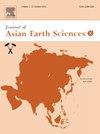Quantitative evaluation and effectiveness criteria for the crystalline bedrock-type reservoir in the central uplift zone of the northern Songliao basin, NE China
IF 2.3
Q3 GEOSCIENCES, MULTIDISCIPLINARY
引用次数: 0
Abstract
The crystalline bedrock-type gas reservoirs in the central uplift zone of the northern Songliao Basin represent a significant target for deep natural gas exploration. However, few studies have evaluated and identified effective reservoirs within this specific zone. In this paper, we present a comprehensive study on several exploration drill cores to constrain the pore structure, fracture parameters, minimum porosity and permeability thresholds required for fluid migration in the crystalline bedrock-type reservoirs in the central uplift zone, in an attempt to establish the criteria for identifying effective reservoirs. The results reveal that nanometer- to micron-sized pores, microfissures, and fracture zones are well developed in the crystalline bedrock-type reservoirs, indicating that they can be classified as low-porosity, ultra-low-permeability reservoirs. The identified thresholds for an effective reservoir consist of porosity of 1.5 % and permeability of 0.015 × 10−3 μm2, and a minimum pore-throat radius of 0.02 μm for fluid mobility. These criteria provide useful guides for identifying effective reservoirs within the crystalline bedrocks.

松辽盆地北部中央隆起带结晶基岩型储层定量评价及有效性标准
松辽盆地北部中央隆起带的结晶基岩型气藏是深层天然气勘探的重要目标。然而,很少有研究对这一特定区域内的有效储层进行评价和识别。本文通过对多个勘探钻井岩心的综合研究,对中央隆起带结晶基岩型储层的孔隙结构、断裂参数、最小孔隙度和流体迁移所需的渗透率阈值进行了约束,试图建立识别有效储层的标准。研究结果表明,结晶基岩型储层中纳米到微米级的孔隙、微裂缝和断裂带非常发达,表明这些储层可以归类为低孔隙度、超低渗透率储层。已确定的有效储层阈值包括孔隙度 1.5 % 和渗透率 0.015 × 10-3 μm2,以及流体流动性最小孔隙-咽喉半径 0.02 μm。这些标准为确定结晶基岩中的有效储层提供了有用的指导。
本文章由计算机程序翻译,如有差异,请以英文原文为准。
求助全文
约1分钟内获得全文
求助全文
来源期刊

Journal of Asian Earth Sciences: X
Earth and Planetary Sciences-Earth-Surface Processes
CiteScore
3.40
自引率
0.00%
发文量
53
审稿时长
28 weeks
 求助内容:
求助内容: 应助结果提醒方式:
应助结果提醒方式:


